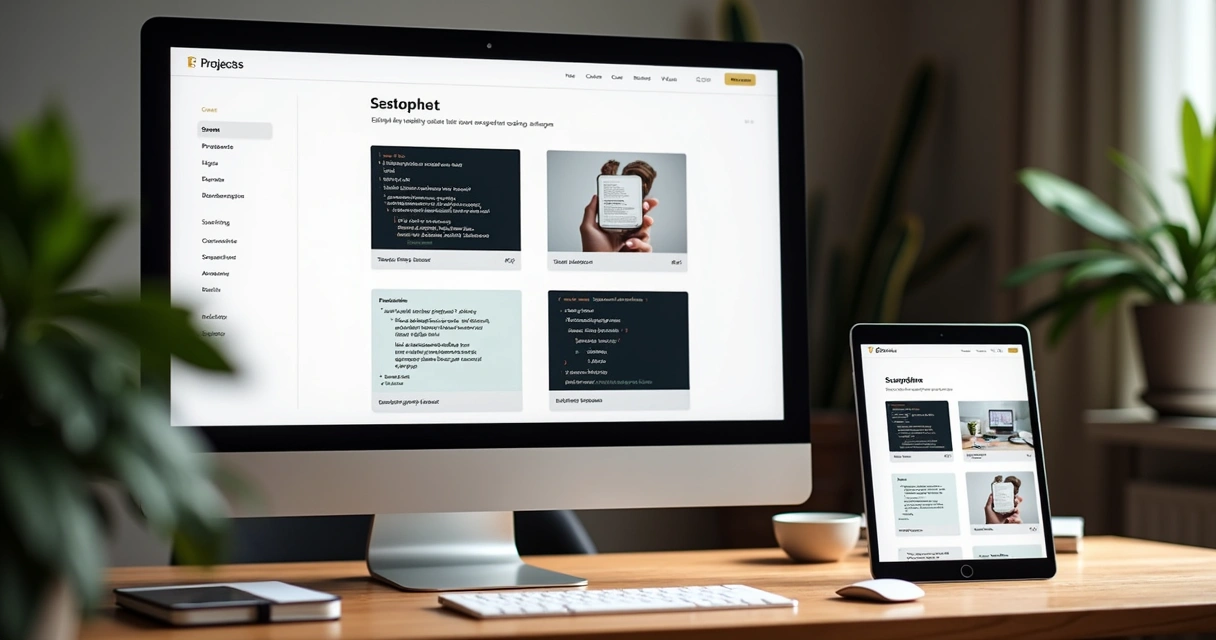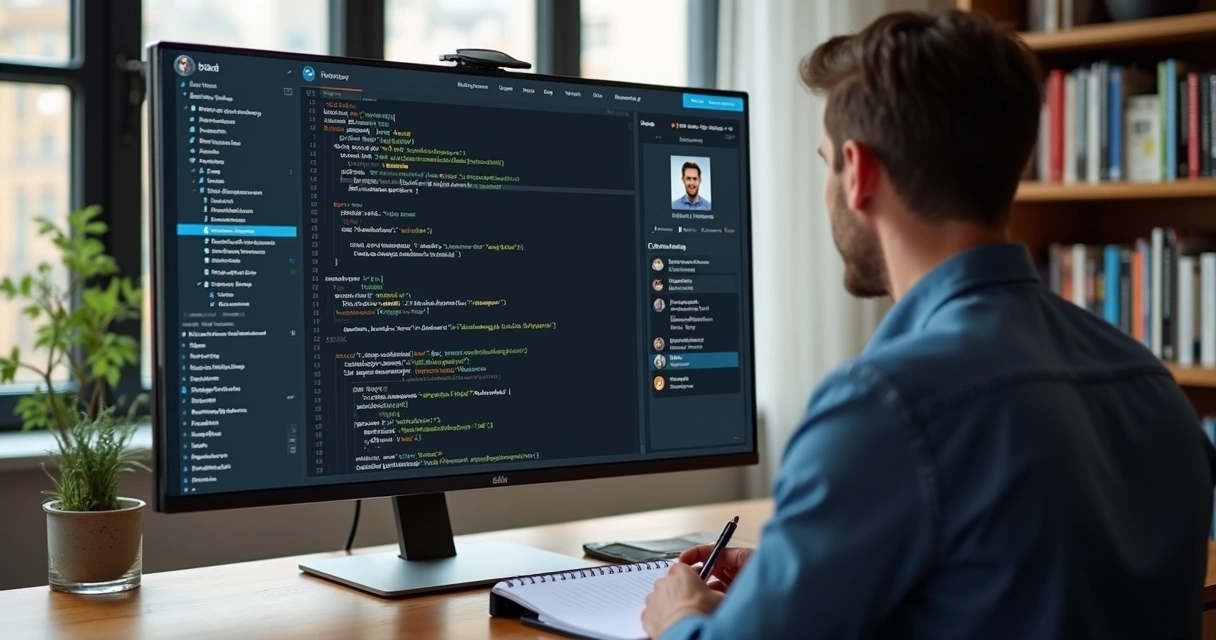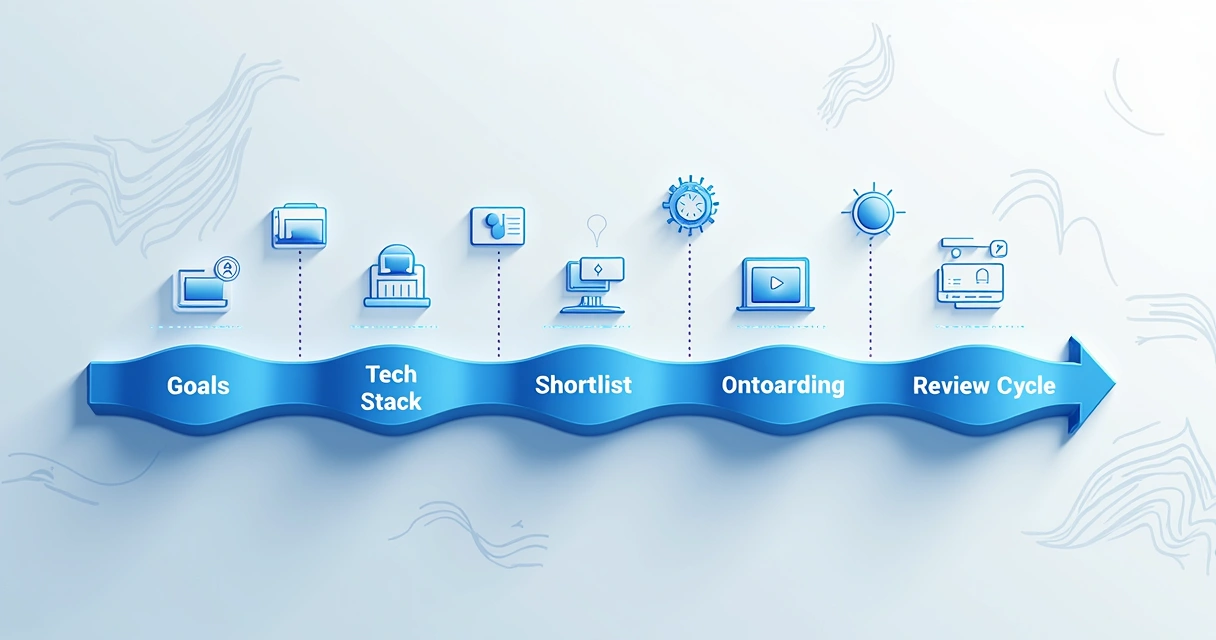Building modern and scalable applications has become more complex and demanding, but also more exciting than it’s ever been in my career. Whether I’m consulting startups, working with enterprise leaders, or helping digital nomads solidify their technical vision, I see one recurring question: how do you hire the right remote full stack developer?
I’ve faced this question many times, both as a hiring consultant and as a senior software engineer myself. Over the years, my clients repeatedly ask for a developer who can handle both the front and back end, thrive in distributed teams, and deliver scalable, maintainable solutions. That’s not simple. But it’s very possible—with the right approach.
In this guide, I’ll walk you through what I believe is the most practical, proven process to find and work with the best remote full stack professionals. I’ll blend my own experience, a look at the current hiring landscape, technical requirements, hiring workflows, and day-to-day strategies to guarantee long-term success. And, every now and then, I'll share why I think working directly with someone like me is usually the most reliable and transparent route over the more faceless, generic alternatives in the crowded market of agencies and hiring platforms.
Why companies are turning to remote full stack developers
Let’s be direct: Modern development needs have changed. In the last few years, the move toward distributed teams and remote-first projects has accelerated. According to the U.S. Bureau of Labor Statistics, over 3% of establishments had at least one job that could be done entirely online as of 2022. For me, working with clients in different time zones, it’s obvious why: remote hiring removes borders, grows the available talent pool, and adds flexibility.
- Global reach: Companies are no longer confined to local or national markets when searching for expertise.
- Cost savings: Remote arrangements may reduce overhead (for both sides), and sometimes let you access competitive rates without sacrificing skill.
- Time zone advantages: Work can happen around the clock or, at least, align with the company’s critical hours, because your developer might be wherever you need them.
- Cultural and creative diversity: Different backgrounds bring fresh ideas—the value of that can’t be understated.
But there’s more at play here. With the rapid pace of tech change, projects require agility and broad technical know-how—exactly what a senior remote full stack developer provides.
The types of projects that benefit most
In my experience, certain business needs align especially well with remote full stack skills. Here’re some examples I’ve seen over and over:
- Building new products from scratch (startups, MVPs, SaaS apps)
- Modernizing legacy systems for the web or cloud
- Developing internal tools that help teams automate processes
- Integrating artificial intelligence and data analytics features
- Scaling platforms with fluctuating user traffic
- Connecting APIs and orchestrating microservices
If you're curious about how modern frameworks fit scalable business goals, my article about web frameworks for scalable business solutions breaks this down even further.
Seamless technical breadth is the quiet engine behind resilient products.
What skills and experience should you expect?
Before you try to hire any remote full stack developer, you must know what you’ll actually need from them. “Full stack” is common jargon now, but expectations vary wildly from one company to the next. Let’s avoid confusion.
Core technical skills
- Front-end development: Proficiency in HTML, CSS, and JavaScript is non-negotiable. More advanced projects require React, Vue.js, or Angular (I rely most on React for complex interfaces, but others have their place).
- Back-end development: Comfortable with at least one major back-end language: PHP, Node.js, Python, and Java are most requested. From my side, PHP (Laravel), and Node.js are common for robust APIs, but I’ve also handled Python/Django projects.
- API development and integration: RESTful APIs are standard; GraphQL is becoming more prevalent. If your project connects to third-party services or microservices, this is especially important. Check out my thoughts on API integration in modern systems.
- Database management: Knowledge of both SQL (MySQL, PostgreSQL) and NoSQL (MongoDB, DynamoDB) is necessary for nearly any serious product.
- Cloud platforms: Familiarity with AWS, Google Cloud, or Azure. I tend to use AWS (EC2, Lambda, S3), and this pays off for scalability and security.
- DevOps tools: Experience with CI/CD (GitHub Actions, GitLab CI, Jenkins), Docker, Kubernetes. If you need rapid releases and safer deployments, this is key. I cover this further in my post on DevOps best practices.
- AI and automation: Increasingly, clients ask for seamless AI integration (machine learning hooks, chatbots, process automation). If that’s in your scope, make sure your developer has experience here.
Experience and soft skills
- Remote collaboration: The ability to communicate well in writing and asynchronously is fundamental.
- Autonomous work ethic: Remote candidates must be self-motivated, capable of handling ambiguity or clarifying fuzzy requirements.
- Portfolio of completed work: Real-world examples usually matter more than certificates. I always tell clients: look at what has actually shipped.
- Problem-solving attitude: Quick learners and creative thinkers outperform those who stick to the “letter” of requirements.
Technical brilliance means nothing if your candidate can't communicate progress or request feedback.
Defining technical requirements and the project stack
I can’t stress enough how defining the right requirements at the start saves pain later. In my own work—especially for clients just getting acquainted with hiring remote engineers—I walk through every item that will impact hiring decisions:
How to clarify your needs upfront
- What’s the primary business goal? (e.g., MVP demo, scalable SaaS launch, internal dashboard)
- What are the technical must-haves vs. nice-to-haves? List languages, frameworks, cloud platforms you’re most comfortable with—or those your existing system depends on.
- What’s the timeline for release and main milestones? This will affect both the candidate’s workload and the recruitment process.
- Is this a fixed-scope project or an ongoing engagement?
- What’s your current tech stack? Is there legacy code the full stack developer must support, or is everything greenfield?
- Are there any special regulatory/security requirements? This can rule out some options before you even post the job.
If you'd like to see practical examples of successful digital projects and the stacks powering them, take a look at my portfolio of completed client projects.

Breaking down the advantages of hiring remotely
There’s a lot of hype around hiring globally, but much of it is well-founded. Over the last decade, I’ve seen companies (from early-stage startups to large enterprises) report serious benefits:
- Broader talent pool: If you only search locally, you face more competition, higher rates, and less diversity. With remote hiring, you gain access to professionals with rare technical or domain experience—wherever they live.
- Scalability and flexibility: Scale your teams up or down as your needs shift. This is difficult if you rely solely on local, in-house employees.
- Faster hiring: Fewer geographical limits streamline your search. You’re no longer waiting for someone in your city to become available.
- Potential budget advantages: You can often balance cost and quality more effectively because rates will vary worldwide. Just don’t chase only the lowest rate—that rarely ends well.
- Resilience: If there’s a local disruption (weather, infrastructure, etc.), a distributed team is less likely to be affected.
- Sustainable work-life balance: Developers who are comfortable working where they live are more motivated long-term. In my case, remote work as a digital nomad lets me dedicate focus to clients without long commutes and external distractions.
I’d say that access to a global talent pool is the reason my clients stay competitive and keep their stack on the cutting edge.
Remote hiring removes borders and unlocks new levels of creative and technical innovation.
The hiring process, step by step
You might think remote hiring is only about using online job boards or technical vetting services, but based on what I’ve seen, the process is more subtle. A well-run process guarantees a better fit, less churn, and faster outcomes. Here's my stepwise take, with details you'd otherwise spend months learning through trial and error.
1. Write a clear job description
Your job posting isn’t just for filtering applicants—it’s a signal to skilled professionals about what you actually need. A high-quality developer is scanning for projects that are well-defined, challenging, and respectful of remote contribution.
- Specify the core responsibilities (e.g., “Develop and maintain cloud-based web apps,” “Integrate machine learning models into our platform.”)
- List required and desired skills but don’t go overboard—target five to seven preferred techs/tools max.
- Avoid vague clichés (“rockstar full stack ninja” doesn’t attract experienced candidates, trust me).
- Mention your collaboration style and the tools you use (Slack, Jira, Notion, Trello, etc.).
- Drop a quick line about your team’s mission, culture, and ways of working.
Want to see a template? Here's a short example I’ve used for myself:
Seeking a senior full stack developer experienced in PHP, JavaScript (React), AWS, and API design. Must be comfortable with asynchronous communication and working across time zones. Familiarity with agile and DevOps a big plus. Prior experience with AI integration is welcome.

2. Source candidates
There are many, many hiring platforms, “talent matching” services, and job boards. However, I find that many companies get better outcomes when they:
- Lean on personal networks, referrals from other business owners, or use their own website to describe the benefits of joining their team.
- Browse carefully curated platforms (top-rated talent only) if they require vetting, but stay wary of sites where it’s impossible to confirm prior work or talk directly to the developer.
- Post in relevant online communities for developers (subreddits, specialist forums, Stack Overflow), but with clear job expectations.
One key difference in my services: I work directly with you, there’s no hidden staffing agency. You get transparency, fast communication, and a referenceable track record—instead of rolling the dice on anonymous profiles. Sure, competitors might brag about their “pool size,” but how much do they really invest in understanding your true business goals? That’s where I stand out.
Direct connections. Real-world track records. No middlemen.
3. Screen applications and portfolios
Always look beyond the resume. In my own hiring or peer vetting projects, I check:
- Specific, relevant completed projects (preferably live, or with detailed documentation/screenshots if under NDA).
- Consistent history of remote work. Can the candidate show results when not in an office?
- Open-source contributions, written blogs, or workshops (these signal both communication skill and technical depth).
- References or testimonials, especially from previous distributed or freelance collaborations.
If a developer can’t point to their real-world output, that’s a flag. You can see for yourself what sorts of projects are relevant by browsing open portfolios like mine—showing not just tech stacks but outcomes for real users.

4. Conduct structural interviews and skills assessments
This part takes care and intention. You want to balance technical depth with culture fit, and also test remote collaboration skills.
- Technical interviews: I advise using real-world problems you’ll actually encounter, not just whiteboard puzzles. Ask candidates to talk through architecture decisions, past mistakes, and trade-offs.
- Pair programming or code reviews: Run a 1-2 hour session—remotely—where you work together on a simple project or feature.
- Asynchronous communication test: Have the candidate explain a technical concept in writing, or document logic for one of their solutions. This tells you everything about attention to detail and clarity.
- Culture and values alignment: Check if they’re comfortable giving and receiving feedback (async and live). If possible, introduce them to your team to see how they interact.
5. Evaluate technical skills practically
In my view, practical tests beat "algorithm quizzes" hands down. I favor exercises like:
- Building a simple API endpoint (e.g., create/read/update/delete operation with authentication and data validation.)
- Wireframing a small interactive UI module based on a mockup or user story.
- Debugging or reviewing a short block of code for security edge cases or performance.
- Deploying an app to a staging environment and sharing steps/documentation.
This shouldn’t take more than a few hours for senior talent—be respectful of their time and avoid unpaid “take-home” assignments if you’re not seriously considering the candidate.
Practical skill wins over theory when you need to launch and iterate, not just pass tests.

6. Reference and background checks
Especially when hiring remotely, always get in touch with at least two prior collaborators—ideally people who can speak to both technical and collaboration skills. This usually flushes out missed details and strengthens your impression of how the developer handles ambiguity, deadlines, and feedback.
7. Make the offer and set expectations
Be honest about your process, payment schedule, communication habits, and what happens if expectations shift. I always recommend a probation period (like 1-3 months) with clear, achievable outcomes. This lets you part ways cleanly if things aren’t working, without drama or blame.
8. Onboarding for remote success
This gets overlooked a lot—but onboarding strong sets the tone for everything that follows. I usually recommend:
- Detailed access to all relevant documentation, repos, communication tools, and sample data.
- An intro call not just with engineers, but stakeholders from design, product, or leadership (even if brief).
- Clear “first week” goals (setup the dev environment, ship a bug fix, review open issues).
- Explicit feedback schedules and a dedicated channel for questions (Slack channel, shared doc, or weekly check-in calls).
The seeds of a successful remote partnership are planted in the first few days.

Best practices for interviewing, technical tests, and evaluating fit
If there’s one thing I’ve learned working with both technical founders and non-technical product leaders, it’s that clear, structured interviews yield the best long-term results. Here’s what I keep in mind (and guide my clients to do as well):
Build an interview funnel
- Intro call: 30 minutes to discuss background, motivation, and remote experience. Look for stories about previous distributed teams, not just lists of tools.
- Technical deep dive: 1 hour dissecting two recent projects. I might ask, “Show me how you made a key decision, what failed, and your fix.”
- Problem-solving task: Short, relevant coding or troubleshooting challenge—ideally in the stack you use. No brainteasers, just tasks that mimic your real workload.
- Culture & process check-in: 30 minutes with a wider team or leadership: communication, feedback, and how the candidate handles async project management.
What I look for in candidate responses
- Depth and honesty: Do they admit past mistakes? Can they explain failures as well as wins?
- Clear written explanation: Are their written answers clear, structured, and jargon-free?
- Evidence of independent problem-solving: Side projects, mentoring, open-source work, and posts are often as important as paid jobs.
- Bonus: Community engagement. Do they contribute to shared learning—workshops, blogs, guides? This signals a generous team attitude.
And when candidates ask me smart, detailed questions about my own services or about how distributed projects run, I know they’re serious about delivery—not just passing the interview.

Collaboration and daily communication in distributed teams
Remote work sometimes gets a reputation for missed signals and slow workflows, but that’s not inevitable. I’ve found distributed teams function well if:
- Everyone uses agreed-upon tools (Slack, Teams, Notion, Jira) with clear expectations for response times and documentation.
- Meetings are structured and necessary (not daily by default). Written stand-ups and async updates actually perform better for focus-driven coding sprints.
- Project tracking is transparent: Kanban boards, ticketing, or roadmap milestones shared in a single dashboard.
- Feedback is proactive and time-bound: Async video, Loom walkthroughs, or quick voice notes often communicate intent better than text alone.
- At least once per week, there’s a live sync call for blockers, priority shifts, and unstructured “surface area” discussion.
Much of this comes down to culture and intention—even the best full stack developer succeeds only if they’re given clear goals and inclusive touchpoints. In my model, I guarantee daily async access, structured weekly checkpoints, and optional deep-dives for major architecture or roadmap decisions.
Transparent async feedback makes remote work smooth and progress clear.

Cost, time zones, and security: Practical things to keep in mind
Salary and budget transparency
How much should you offer? According to Jessup University data for 2024, remote full stack developers make about $117,880 a year on average, while seniors earn around $114,556 (which may reflect wide international competition). These are averages, though. In my practice, rates can shift up or down based on specialization, project urgency, and experience level.
Remember, while the temptation exists to secure a lower rate, I always recommend prioritizing skill, transparency, and long-term fit over the headline cost. As U.S. Bureau of Labor Statistics research supports, quality web developers command higher wages for a reason: they drive projects to completion, faster, and with fewer bugs.
Time zone and scheduling strategy
Distributed doesn’t have to mean “out of sync.” What I see working best is:
- Overlap at least 2-4 hours of working time each day for check-ins and live support.
- Document everything, so team members in other locations can continue progress when you are offline.
- Flexible approaches: sometimes I’ve shifted my hours for week-long sprints if a client needed direct, fast iteration. But do confirm this in advance to avoid friction later.
Security practices and data protection
As a remote contributor, I treat data as sacred—and expect the same mindset from all distributed engineers. Here’s what I recommend:
- Onboard using least privilege principles: Only give access to what’s required for each project phase.
- Strong password management and multi-factor authentication on all systems.
- Regular code and dependency reviews for vulnerabilities.
- Clear NDAs and work-for-hire contracts to set expectations and reduce risk.
- For regulated environments: request candidate experience with specific compliance frameworks (GDPR, HIPAA, SOC2, etc.).
Security is built on trust, attested experience, and proper onboarding.

How to build long-term partnerships with remote full stack professionals
I’m convinced—and I see it in client feedback year after year—that successful remote partnerships function much like in-house teams if you invest in transparency, autonomy, and appreciation.
- Define clear performance metrics and revisit them monthly.
- Invite input on roadmap, not just “tasks to do.” Senior contributors (like myself) should feel ownership and accountability for business outcomes, not just code completion.
- Regularly review process and communication practices. Always ask: what’s working, what isn’t, how can it be improved?
- Invest in ongoing learning—this could be sponsoring a course, or simply supporting contributions to open source or research.
- Show appreciation. A simple thank you in group channels, sharing customer wins, or inviting remote contributors to planning sessions builds loyalty better than any financial incentive alone.
The best remote collaborators are partners, not replaceable contractors. In my case, I aim to become a trusted advisor to every client, not just a temporary extra set of hands.

How Adriano Junior delivers on full stack remote opportunities
You’d be right to wonder whether to hire a freelancer, an agency, or to go the “big platform” route. There are lots of options. But from my vantage point—where I offer direct consulting, hands-on engineering, and architectural leadership—I repeatedly hear the same reasons why clients choose my services:
- Accountability and transparency: You work directly with a senior engineer and consultant (that’s me), not with intermediaries or shadow teams.
- Technical depth and broad skillset: Over 16 years experience, a wide stack (from PHP/Laravel to React/Node, AWS, DevOps, and AI integration), and a documented history of delivering on time for multiple industries.
- Process-driven, partnership approach: I invest in understanding business context first—then propose technology, always with long-term maintainability and flexibility in mind.
- Flexibility in engagement: Project-based, long-term retainer, or a focused technical audit—you decide what matches your needs.
- Trust and communication: You always know what’s happening, where time is spent, and how problems are being solved—directly from your engineer, not a project manager proxy.
Most agencies or large freelance hubs, while sometimes useful, simply can’t provide this level of personalized, senior attention at every stage. When you want a product shaped by hands-on knowledge—without the delays, feedback lags, or bureaucratic hurdles—I deliver that experience, directly.
If you’re interested in the varied ways I support clients, honest project feedback and detailed proposals can be found throughout my services section.
Strong partnerships are built on mutual trust, clear communication, and shared ownership of success.
Getting started: A step-by-step action plan
- Clarify your core goals and milestones. Write them out; be specific about why you need full stack skills and what success will look like.
- Identify your target tech stack and “must-have” vs. “nice-to-have” skills. Prioritize.
- Draft a transparent job description (or, even better, send me your business plan/tech stack and I’ll help co-create a scope document).
- Shortlist vetted talent with proven remote track records. Don’t get swayed by the lowest bid or by agencies who can’t show direct results similar to your goal.
- Structure your interviews and tests as outlined above. Practical, context-driven assessments will always yield the most reliable results.
- Set clear expectations for onboarding, collaboration, and communication rhythms.
- Invest a little extra attention during the first month. Rapid feedback cycles, iterative learning, and mutual trust-building pay huge dividends over a remote project’s life.

Conclusion
After many years in this industry, I’ve seen what separates projects that soar from those that stagnate. Often, the difference is not in the number of features or the complexity of the codebase, but the quality of collaboration and the match between goals and team skillsets. A remote full stack developer, when chosen thoughtfully, gives you more than just code delivered—they provide perspective, agility, and partnership.
If you want your project to keep pace with new technologies and customer demands, start by defining your priorities, and reach out to those who are not only willing, but excited to become a true part of your journey. I am always happy to help you scope your needs, offer insights on technical strategy, and, if it’s the right fit, take your vision from abstract roadmap to working product. Don’t settle for generic agencies or faceless platforms: choose trusted, senior partners invested in your long-term growth.
Ready to launch or scale your next project with a senior remote full stack developer and digital consultant? Contact me directly or browse my project portfolio to see the kind of results we could achieve together.
Frequently asked questions
What is a full stack developer?
A full stack developer is a software engineer skilled in both front-end (user-facing interface) and back-end (server-side logic, databases, APIs) development. They can design, implement, and support all parts of a web application, often acting as a bridge between design, user experience, and system infrastructure teams. In my own work, I regularly combine client-side technologies (like React or Vue), server frameworks (such as Laravel or Node.js), and cloud systems (AWS) in a single workflow to speed delivery and cut down on cross-team miscommunications.
How do I hire a remote full stack developer?
To hire a remote full stack developer, clearly define your project's technical requirements and goals, write a transparent job description, and search for experienced candidates with proven distributed work history. Review detailed portfolios, conduct practical tests, and prioritize communication skills. I recommend direct collaboration with known professionals (such as my services) for better outcomes over generalized agency pools. Structured interviews, clear onboarding, and early feedback cycles will quickly reveal who fits your business and team culture.
Where can I find top remote full stack developers?
You can find remote full stack developers through trusted personal or professional networks, curated job boards for tech talent, developer community forums, and by searching portfolios of established freelancers. Many companies also check open-source contribution histories for reputation. It’s easy to get lost on large freelance platforms, but working with specialized consultants who can back up their work with real references and demonstrable client results is usually a safer bet—that’s what sets my approach apart from generic hiring solutions.
How much does it cost to hire remotely?
Remote full stack developer rates vary widely. For 2024, Jessup University reported median annual wages for remote full stack developers around $117,880, with senior roles just above $114,000. The exact cost depends on technical specialization, project length, and the developer’s experience. Flexible project-based or retainer arrangements, like those I offer, mean you’re not locked into unnecessary expenses or generic agency markups. My focus is always on delivering clear value tied to tangible milestones.
What skills should remote full stack developers have?
Remote full stack developers should master at least one front-end and one back-end language or framework (for example: React and Node.js, or Vue and PHP), understand API development, and manage both SQL and NoSQL databases. Practical knowledge of cloud platforms like AWS or Google Cloud, DevOps tools (Docker, CI/CD), and experience with remote communication tools is also important. Beyond technology, strong written communication, self-management, and problem-solving mindset are just as valuable in remote contexts.
